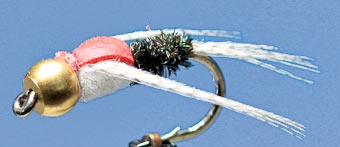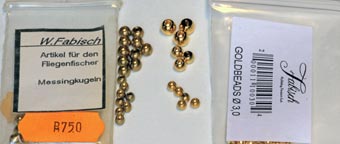.
- Steelhead trip 2013
- Meeting 2014
- BC Trip 2014 / 1
- BC Trip 2014 / 2
- BC Trip 2014 / 3
- BC Trip 2014 / 4
- BC Trip 2015
- by W. Fabisch
- Angling or fly fishing
- Norvise Tuning
- Norvise Tuning Two
- How to use while...
- With strike Indicator
- How to fish nymphs
Gold Bead Head Nymphs Fly Tying and Fishing
Why are nymphs with gold bead heads so efficient while fly fishing?
.
These patterns secret
.
About the bead head history
 the DENDIF with a gold bead head, a real killer still today
the DENDIF with a gold bead head, a real killer still todayThe first time I learned about this type of nymph - the one with a golden pearl for a head - was quite a long time ago fly fishing on the Gmundener Traun in Austria. Two of my friends and myself had been fishing around a little island called Fischerinsel, without too much success. A group of Italian anglers on the opposite bank had decided to take a break and were lying about in the grass. There just weren't any takes anywhere.
It was just before noon when another angler showed up on our side. We exchanged our hellos and he started casting his fly about 35 yards downstream from us.
It must have been about three or four casts later that he hooked a nice grayling, and he kept right on just like that. After his third fish, the Italians across the river took notice, and their heads appeared above the high grass. Shyness not being one of my most obvious qualities, I decided to check what was going on there.
.
This successful angler was in no way secretive when I asked him about the fly he was using, and reeled in his line to show me. Now I don't mean to say I was disappointed, but the fly he showed me didn't really impress me much.
He told me he had gotten a few of these shiny patterns at the "Wirt am Bach" - a well known local restaurant with a fly shop attached. When I asked if those golden beads were also available for guys preferring to tie their own he said that they were on sale, but he had no idea as to the price because he didn't tie. It goes without saying that I bought the first of those pearls that very night and immediately started to tie my own patterns with pearls.
The owner of the restaurant told me that Roman Moser had just brought these gold beads back from a trip to the US. They were made of brass and had a spacious bore right through the center. The bore was so wide you could put them on over the hook's eye. It was one heck of a job to get them fixed by pressing them down on lots of turns of tying thread well soaked with head cement... ! You had to be pretty lucky to avoid them getting loose and sliding up and down on your tippet. Even so, these kind of patterns were a real success.
.
.
About business
.
At that time, my fly fishing school and the little fly shop I ran with it were quite young, and I got so mad tying flies with those pearls that I decided to invest some time and money to find a better solution. First I got all kinds of hooks to make sure the new brass pearl I would develop should work on almost any hook design. Next I got me a couple of brass bars with diameters of 3, 3.5, and 4 mm and got started experimenting. I started by drilling a deep enough bore down the center of the bar with a small diameter drill followed by a drill with slightly larger diameter, not quite as deep; then I used a lathe to machine my bead, and cut it off. Next I tried to push my pearl from the hook's point against the eye.
 on the right hand side you see the little plane on the front
on the left hand side you see the tapered bore
on the right hand side you see the little plane on the front
on the left hand side you see the tapered boreDuring this phase of experimenting, many a bead and many a tool flew around my shop, and sometimes I felt like abandoning the whole project. Finally, I came up with a taper fitting my diverse diameters and hook patterns. Fortunately, there are several companies in my area specialized in machining tiny screws for compasses. Some of them were kind enough to give my beads a try on their automatic lathes.
As my beads offered a considerable advantage to those previously available I could soon get a few customers. The next step was gold- plating the beads, and from then on we had real gold-bead nymphs that performed up to that name.
.
.
.
 on the left some old brass patterns dating from the last century
on the right today's gold-plated version
on the left some old brass patterns dating from the last century
on the right today's gold-plated version.
.
All of these events date back to before 1990 and thus I'm pretty sure to have been the first to market gold beads with a tapered bore, at least in German-speaking countries. Well-known and important wholesale suppliers have been faithful customers to me until today. Of course, there's always some who get lured astray by Asian prices. By the way, you can easily identify my beads by the little plane on the front side of the bead, caused by machining on the automatic lathe.
.
.
The effect of this patterns on fish
.
The success of this patterns is still extraordinary. Even anglers fishing a fly for the very first time in their lives have a hard time avoiding strikes. Anyone who has seen Roman Moser's video on caddisflies will remember the gas bubble in the thorax area of emerging caddis. So, one of the reasons for this flies success is color. The sink rate of this pattern is another reason, and this holds particularly true for the brass based version. Of course, tungsten versions can sink deeper faster, but they will not match the elegance of the drift of patterns with gold plated brass beads. Therefore, circumstances permitting, I still prefer nymphs with gold plated brass beads to tungsten versions, even when steelheading in Canada.
Some years ago I have field-tested hooks with just the gold bead and a little lead wire to hold the bead in place - like the hooks with gold or nickel plated beads I offer ready to tie. The success on grayling was so overwhelming that people said grayling were addicted to gold bead nymphs. This is still true to a large extent, except for some rivers with lots of fishing pressure where fish have learned to distrust those golden beads.
These bead heads are not only good to fish, they also help with your tying. The start at the hook eye always looks immaculate, the rear end of the bead helps to perfectly align your hackle etc. etc.
.
Wishing you fun and success for all your activities involving golden bead head patterns!
Yours truly,
.
Wolfgang Fabisch
.
Wolfgang Fabisch, Nürnberger Str. 45, 90542 Eckental/Germany
✆ Germany 011 49 9126 288640, Fax 011 49 9126 288643, Wolfgang Fabisch